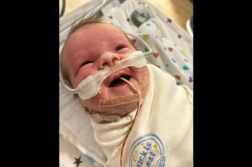Ronald Buckanovich, MD, PhD, is a professor of medicine at the Women’s Cancer Research Center at the University of Pittsburgh, the Hillman Cancer Center and the Magee-Women’s Research Institute. He talks about improving ovarian cancer treatments with the help of “hedgehog inhibitors.”
Interview conducted by Ivanhoe Broadcast News in December 2021.
I want to talk about immunotherapy treatments for ovarian cancer. Do women and doctors have a lot of options when it comes to treatment?
DR BUCKANOVICH: For immunotherapy in ovarian cancer, it’s unfortunately been disappointing. While it has been a watershed moment for many other tumor types, immunotherapy response rates have been a bit disappointing for ovarian cancer. There’s good evidence that women’s immune systems can respond to their cancer, but for some reason, it seems to hit a barrier. So, in the larger studies, the response rates for immune therapy for women with ovarian cancer have been around 10, 15% and the responses haven’t been as long as we’d expect. For patients with melanoma or lung cancer, they get what we call duration of response, where they can be on therapy for years. We’re not seeing as much of that in ovarian cancer, we see some. But that is case for only 10% of responders, so we need to do better.
Do researchers have any indication why that is?
DR BUCKANOVICH: In ovarian cancer, the surrounding cells –what we call the microenvironment — can be very immune suppressive. Ovarian cancer loves to spread into the fat in the abdomen and it can grow in a fluid called ascites. The immune cells that get there are not the kind that we want, or when they get there, they can be banned from the tumor, which can become problematic. The microenvironment recruits “bad” immune cells and prevents the good immune cells from getting into the tumor to kill the cancer cells. While these “bad” immune cells are important because they prevent you from having autoimmune diseases like thyroiditis and colitis. in cancer, they prevent the immune system from coming in and recognizing those cancer cells, so the immune system is not active.
Tell me a little bit about the research that you and your colleagues have done.
DR BUCKANOVICH: We are very interested, specifically, in that tumor microenvironment. We’ve studied a cell type known as mesenchymal stem cells—or MSC for short. MSC are normally found throughout the body. The MSC’s job is to perform a role in wound healing, which is one of their major jobs – they make the scar tissue for if you cut yourself, they turn on blood vessel growth so you can heal with those blood vessels, and then, they turn off the immune system because you don’t want chronic inflammation when you have a wound. But in cancer, that cell gets co-opted. The cancer cell reprograms to do all those things to help the cancer grow so, they come in and make blood vessels grow. The MSC will put up a scar barrier, called desmoplasia, that will create a physical barrier around the tumor, and they inhibit – they shut off the immune cells. So, we were very interested to see what those cells were doing. What we found when we looked in mouse models, and in human samples, was that when those mesenchymal stem cells were present, they did something called tumor immune exclusion. In tumor immune exclusion, a barrier is created that prevent tumor killing immune cells from getting into the tumor. Normally, for patients with effective immune cells, they can get right next to the tumor cells and kill them. That’s their job. These mesenchymal stem cells create a barrier so the T cells come to the tumor, but they get stuck on the outside and they can’t get in and do their job. I like to describe that like, “Imagine if there was a fire in downtown Pittsburgh, if the tunnels and the bridges and the freeways coming into town were closed, the firemen couldn’t get in to put out a big fire in the center of town. They might try to weave through the suburbs a little bit, but they’d never get there in time.” That’s what we’re seeing with these immune cells.
What’s the implication? What can you do once you’ve identified these stem cells that play such an important role?
DR BUCKANOVICH: Once you’ve identified them, then you can figure out therapeutic targets. What we’ve known in the past about these cells is they depend on a pathway called the hedgehog pathway, which is a silly name. “Sonic the Hedgehog” played a role, for the game players out there. But there are drugs which inhibit this hedgehog pathway that are FDA approved. They’re used to treat diseases like basal cell carcinoma and medulloblastoma. So, we took those drugs and we said, “Could we overcome the ability of these mesenchymal stem cells to turn off the immune system?” When we treated mouse tumors that contained MSC and normally do not response to immune therapy with a hedgehog inhibitor, we could reverse the effect of those mesenchymal stem cells. With the addition of a hedgehog inhibitor to the immune therapy, immune cells could get into the tumor, and we could cure 50% of the mice of their tumors.
Is this almost to the point where it can be tested in humans? Are you almost ready for clinical trials?
DR BUCKANOVICH: We are, and we are currently filing with the FDA for an IND approval. These drugs have never been used in ovarian cancer patients, but they are FDA-approved drugs. We are partnering with one of the pharmaceutical companies to give us both an immune checkpoint inhibitor, one of these immunotherapies that we’re using in cancer patients, combined with a hedgehog inhibitor so, we’re going to treat ovarian cancer patients. We’ve written the trial and once we get FDA approval, there’ll be a trial to prove they’re safe, but then we’re also hoping to prove they’re effective. We’re hoping to start this late spring to early summer 2022.
What’s the importance of having another way of treating women with ovarian cancer?
DR BUCKANOVICH: For women with ovarian cancer, we like to think we’re trying to transition it to a chronic disease. I sometimes describe it like we’re fighting a battle. For example, if we’re in a foxhole and you’ve only got so many bullets, some of those bullets are going to be blanks or they might not work as well as we might like. One more bullet might the magic bullet, and maybe we can fight our way out of that foxhole. So, the hope is that this is one more weapon in the armamentarium, and maybe for some of these patients, this is the magic bullet. You don’t know until you try. We’re also trying to make this a very patient-friendly trial so, we’re going to take it for all patients with very few exclusions so that we can test this trial and know answers relatively quickly rather than being very restrictive to a subset of patients.
You mentioned that both the hedgehog inhibitors and the mesenchymal stem cells are already the agents. Are they FDA approved?
DR BUCKANOVICH: Both the drugs we will use in this trial are FDA approved drugs, however they are not currently approved to treat patients with ovarian cancer. One of the drugs we are using is in the class of “immune checkpoint inhibitors”. The drug we’re going to use is called atezolizumab and we’re already using to treat melanoma, lung cancer, and others. We’re going to take this drug and combine it with the hedgehog inhibitor so, patients can get two drugs with no placebo, and then, we’re just going to see if they are safe when combined. We think they should be safe as there is some data with a similar combination in another trial showing that they’re safe. And then we’ll see how effective they are.
How many women are you looking to enroll in a first trial? And is Pittsburgh the only site or is this a multi-site?
DR BUCKANOVICH: This will be a single site. It’s 36 patients. It’ll be exclusively here at Pittsburgh. With the trial, because it hasn’t been combined, we really want to keep reasonably tight control to make sure that it’s being done appropriately.
I know that our viewers will want to know, why is it called a hedgehog inhibitor?
DR BUCKANOVICH: Hedgehog was a mutation back in the fruit fly and lots of what we know about genetics comes from the fruit fly a long time ago. So, there’s a hair and it changed the way the hair on the fruit fly stood up and it looked like a hedgehog when they have that particular mutation. But the hedgehog gene is very important for the development. It’s a very important gene, and it’s had huge impacts in cancer because it is a developmental regulator. That’s why these drugs were developed for specific hedgehog-mutated tumors. But we’re hoping this could expand to lots of tumor types. Because what we see in ovarian cancer may hold true for other cancers which are also immunosuppressive and nonresponding.
You mentioned “Sonic the Hedgehog.” Does that character play a role in some way?
DR BUCKANOVICH: “Sonic Hedgehog” is one of a family of genes in the hedgehog family. When Sonic hedgehog was discovered, it was named after the video game, “Sonic the Hedgehog.”
Is there anything that you would want to make sure that people know?
DR BUCKANOVICH: I would just make sure people know that trials are critical for us to learn. Enrolling in a clinical trial is challenging and they are lots of work for patients. They are important, and they help the next generation of women. We’ll know when we run this trial if it will help the women that come after. So, I would encourage patients to participate in clinical trials and I would like to thank for those that have, because it’s so important that we learn and help the women who come after.
Are these drugs administered through IV, are they oral?
DR BUCKANOVICH: A mixed combination.
So, will there be a commitment of people needing to come here for the IV?
DR BUCKANOVICH: They would have to be here in Pittsburgh.
END OF INTERVIEW
This information is intended for additional research purposes only. It is not to be used as a prescription or advice from Ivanhoe Broadcast News, Inc. or any medical professional interviewed. Ivanhoe Broadcast News, Inc. assumes no responsibility for the depth or accuracy of physician statements. Procedures or medicines apply to different people and medical factors; always consult your physician on medical matters.
If you would like more information, please contact:
Asher Jones
Sign up for a free weekly e-mail on Medical Breakthroughs called First to Know by clicking here




